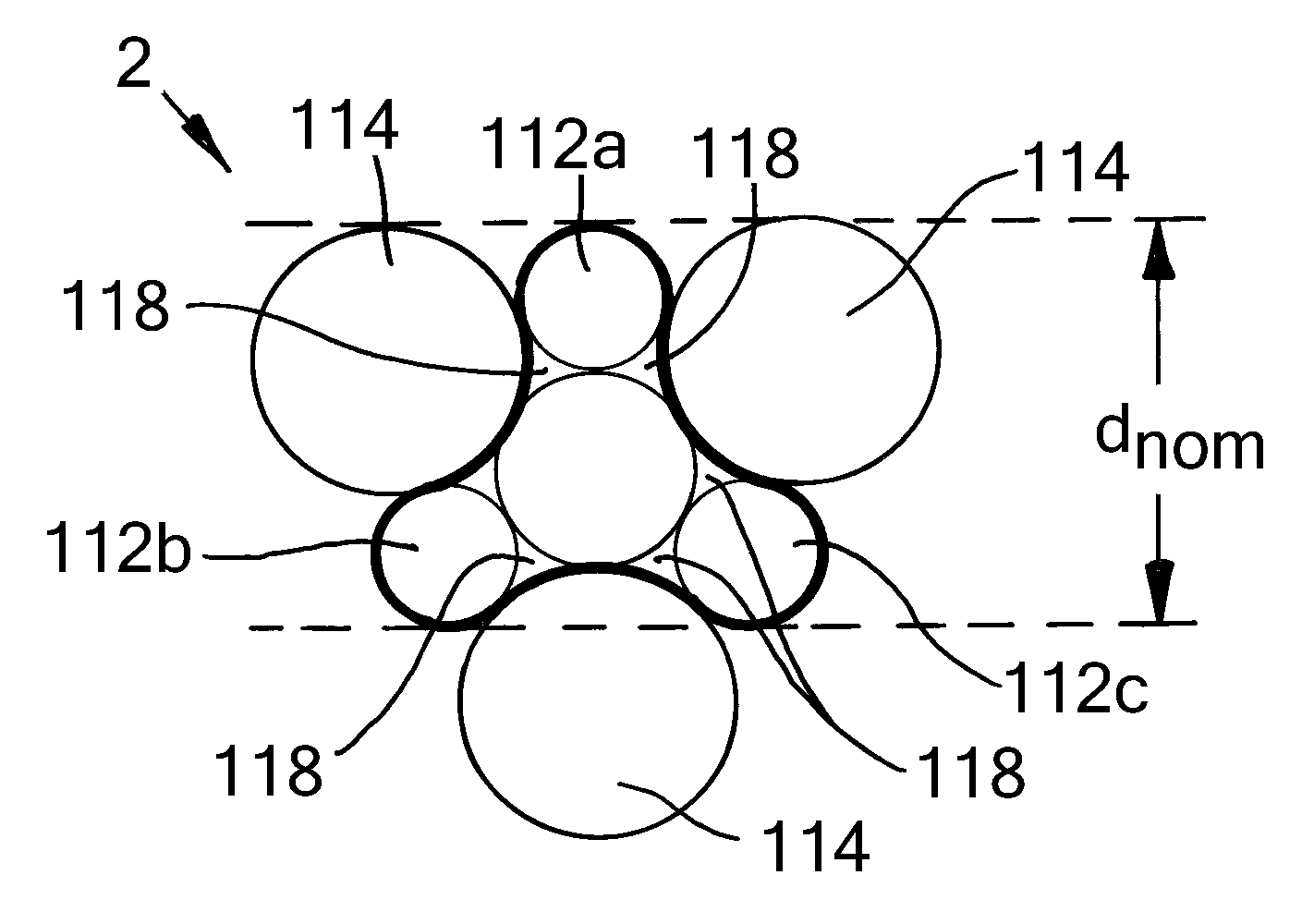Catalyst, catalyst precursor, and catalyst carrier
a catalyst and precursor technology, applied in the direction of catalyst activation/preparation, metal/metal-oxide/metal-hydroxide catalysts, natural mineral layered products, etc., can solve the problems of too restrictive mass transfer limitations, complicated design of further improved catalyst particles, and inability to achieve the effect of achieving the trilobe shap
- Summary
- Abstract
- Description
- Claims
- Application Information
AI Technical Summary
Benefits of technology
Problems solved by technology
Method used
Image
Examples
example 1
[0102]The cross-section of a preferred embodiment of a catalyst, catalyst precursor, or catalyst carrier according to the present invention is presented in FIG. 3. The shape is defined by a central circle 110 surrounded by six outer circles 112, 114. Only circles 110, 112 are occupied, not circles 114. Interstitial areas 118 are also occupied.
[0103]The central circle 110 has a diameter which is 1.5 times larger than that of the outer occupied circles 112. The unoccupied circles 114 have a diameter which is twice the diameter of the occupied outer circles 112. This shape of extrudate provides a surprising balance between sufficient strength whilst also minimizing diffusion limitation within a fixed bed multitubular reactor.
[0104]The nominal diameter ‘d nom’ is the length from the furthest point on one outer occupied circle 112a through the centre of the central circle 110 extending to a line drawn between the bottom of each of the remaining outer occupied circles 112b, 112c.
example 2
[0105]A Fischer-Tropsch catalyst according to the present invention was prepared comprising cobalt (as catalytically active metal), manganese (as promoter), and titania (as catalyst carrier). The shape of the cross-section of the Fischer-Tropsch catalyst particles was as shown in FIG. 3. The average length of the particles was 1.7 mm.
[0106]A comparative Fischer-Tropsch catalyst was prepared comprising cobalt (as catalytically active metal), manganese (as promoter), and titania (as catalyst carrier). The shape of the Fischer-Tropsch catalyst particles was like the shape shown in FIG. 1 (TL-shape). The average length of the particles was 1.7 mm.
[0107]The CO2 selectivity for these catalysts was tested. CO2 is an unwanted by-product and is preferably minimized.
[0108]At a comparable operating temperature and comparable productivity, unwanted CO2 production is 33% lower on the catalyst in accordance with the present invention as compared to the comparative TL-shaped catalyst.
[0109]Indeed ...
example 3
[0110]A Fischer-Tropsch catalyst according to the present invention was prepared comprising cobalt (as catalytically active metal), manganese (as promoter), and titania (as catalyst carrier). The shape of the cross-section of the Fischer-Tropsch catalyst particles was as shown in FIG. 3. The average length of the particles was 1.7 mm.
[0111]A comparative Fischer-Tropsch catalyst was prepared comprising cobalt (as catalytically active metal), manganese (as promoter), and titania (as catalyst carrier). The shape of the cross-section of the Fischer-Tropsch catalyst particles was as shown in FIG. 2 (Tx-shape). The average length of the particles was 1.7 mm.
[0112]Regarding strength, the attrition index of both catalysts was determined by rotating the catalyst particles within a drum with one internal baffle plate, over a standard number of drum rotations. The loss of material was then determined as the change in weight of material below 0.84 mm, judged as being “fines”.
[0113]The attrition...
PUM
| Property | Measurement | Unit |
|---|---|---|
| diameter | aaaaa | aaaaa |
| temperature | aaaaa | aaaaa |
| temperature | aaaaa | aaaaa |
Abstract
Description
Claims
Application Information
 Login to View More
Login to View More - R&D
- Intellectual Property
- Life Sciences
- Materials
- Tech Scout
- Unparalleled Data Quality
- Higher Quality Content
- 60% Fewer Hallucinations
Browse by: Latest US Patents, China's latest patents, Technical Efficacy Thesaurus, Application Domain, Technology Topic, Popular Technical Reports.
© 2025 PatSnap. All rights reserved.Legal|Privacy policy|Modern Slavery Act Transparency Statement|Sitemap|About US| Contact US: help@patsnap.com


